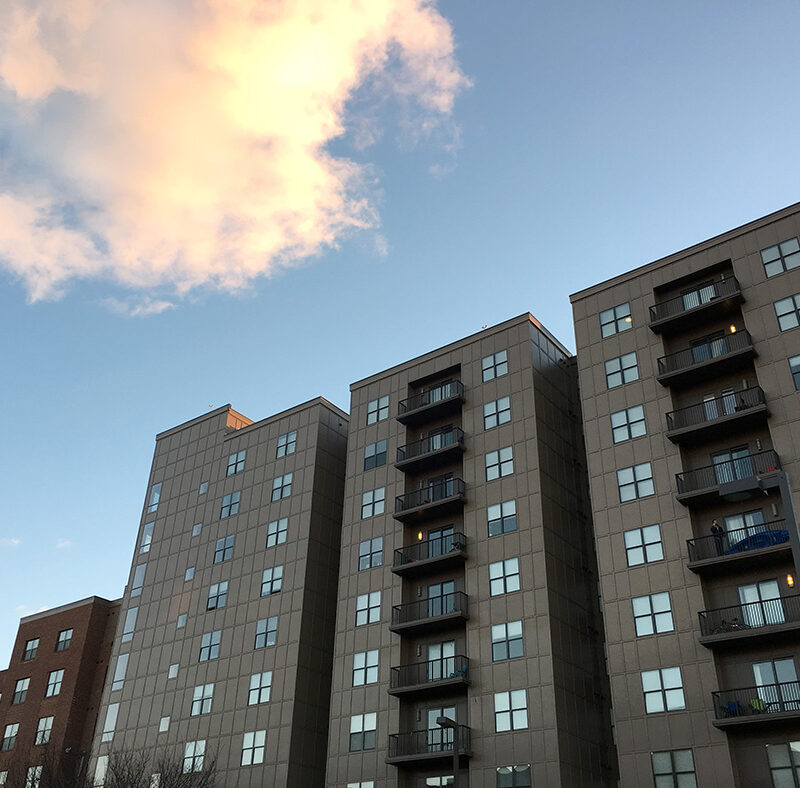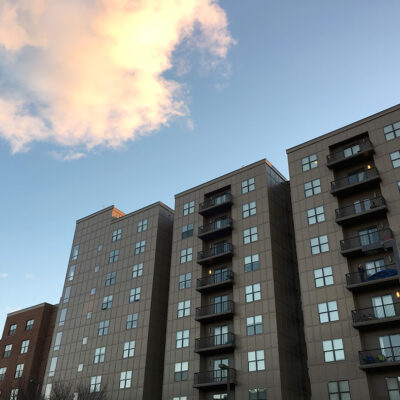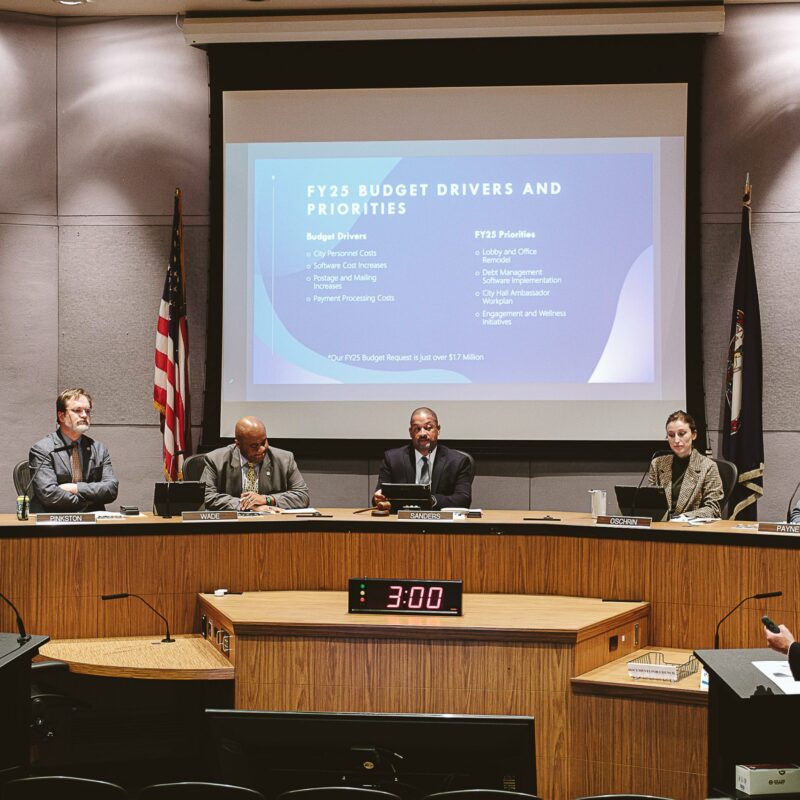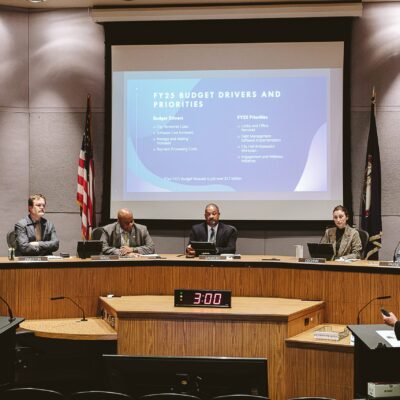On a bright, chilly Monday morning two days before Election Day, Edward Thomas and I stand at the perimeter of the bamboo forest at the corner of Cherry and Ridge in Fifeville, not far from where the 35-year-old painter lives. For 10 minutes, we’ve been tracing the sidewalk, searching for a buried path into the overgrown lots that are rumored to have been a graveyard at the turn of the last century. The forest has been divided into six plots, four of which are owned by a developer who wants to build 64 residential units. The remaining two plots, which belong to the city and which the developers are pressuring them to sell, are less steep and have road frontage; without them, the project can’t go forward. According to Thomas, the city claims that if they don’t sell, Southern Development will build anyway, and the city will have no oversight. “And that was a lie.”
It’s a lie that has pitted the painter, brush held up to a fleet of bulldozers, against powerful interests that are at work both behind the scenes and in public. “Oh, the whole project is green,” Thomas says, wrinkling his face and doing his best sarcastic PR voice. “We’re going to use bamboo flooring, yeah, made in China, with tons of glue and formaldehyde, then shipped here on giant ships.” Thomas imagines the development as another step in the gentrification of Fifeville. The next will be complaining about the “criminal activity” in Tonsler Park, until presto!—Fifeville is just another white neighborhood.
Two years ago, Edward Thomas began his efforts to save this forest. Did he start by petitioning City Hall? Well, in a way. “I did a giant painting from outside the forest, and I made these full-sized prints of it and sent one, along with my big letter, to each of the city councilors and the mayor. One of the people framed it and still has it in her office. I was thinking, ‘O.K., if I made something so beautiful and valuable and gave it to them, then maybe it would effect them, not buying a vote, but that they would be shamed.’” And were they?
 |
“They’re never shamed, man. There’s so much the public doesn’t know about, the back door deals with the developers.” What follows would keep a room full of lawyers busy for a while. We’re standing within earshot of the little gurgling stream Thomas claims will be filled in soon. There’s a respirator mask at my feet, and an old tent I mistake for an American flag, buried in the understory and dead leaves, where yesterday’s art student slummed it for a summer, judging from the beer cans and art mags. The bamboo is so crowded that there’s not even the usual shafts of sunlight reaching down to the forest floor, so when I ask the question, I can’t imagine anybody painting down here.
“Do you ever feel that if you paint something well enough, you can save it?” The answer comes without hesitation: “Yes,” he says. When I ask about plans to paint down here, he gets an excruciated, tortured expression on his face. “I’ve felt compelled to ever since I started my crusade.”
Thomas didn’t start painting because he was on a crusade. In fact, he hates what he calls “issue paintings.” When I’ve asked him what kind of child he was, he’s been blunt: “lonely, awkward, fat.” And it wasn’t the trauma of his father’s suicide when the artist was 13 that started him making art. That began much earlier and for a simpler reason. “I didn’t have any friends.” The early materials were also simple: construction paper and crayons, but the maps of faraway, make-believe lands were anything but. At the same time, Thomas’ father arranged family trips to the art museums in Washington D.C., and New York. It was at MOMA that Thomas stood as a child, struck dumb by Van Gogh’s “Starry Night.”
“I was definitely moved by it,” he says, along with Calder’s mobiles, and Hopper’s “Rooms by the Sea.” In those three early influences, one senses Thomas’ triangle of interests: 1) architecture and building things (such as his current Fifeville house, a kind of hipster-Monticello I happen to live in), something you can see in his dioramas of Sugar Hollow, for example, or the construction site of the new Landmark Hotel Downtown, composed with structural integrity and geometric, Cezanne-like brushstrokes; 2) his own versions of Hopper’s half-abandoned cityscapes, writ large and small on the streets of Belmont or Fifeville; and 3) the globular intensity of Van Gogh’s colors. But where does the subtle political focus come from?
 |
Was it from his father’s death, which he says “just made me bury myself further in my art, seeking the affirmation I never got from my father”? Was it a way of channeling the visceral, immediate, dramatic—and over his early, formative years, manic and occasionally dangerous—relationship to art that began with hoarding blocks in kindergarten and reached its first culmination when a high school art teacher gave Thomas a set of oil paints? “Normal kids in high school did not get oil paints,” he tells me. “I just remember the intense magic of the smell. I’d stay up all night long and make these amazing art projects that would just bowl over my teachers and crush everyone else, which further ostracized me.” Things came to a head just after Thomas graduated from the UVA architecture school and well…let’s just say he got himself together and stopped pulling all-nighters. These days his routine is way less exciting—two hours painting in the morning and two hours painting in the afternoon, followed by manual labor around the house and capped off with a nightcap at the Blue Moon Diner—Morgan’s Rum, pineapple juice and nutmeg, also known as a Captain Edward. It’s as if the more subtly daring the work got—one example would be his series of four paintings of Trax Nightclub being torn down; another, a single sign in a meadow with the word H on it, where the new hospital will go—the more noble the effort, the more steady and boring his daily routine became, though one senses from his friends that the agony still lurks beneath the paint-spattered surface.
“He started painting because he doesn’t have an innate sense of self-esteem, and because of the trauma of his childhood. It’s like his well empties every night and he has to fill it up each day. I think he’s afraid not to do it,” says friend and collector Jane Matthews, seated in the artist’s kitchen, underneath a circular diorama of Charlottesville painted from the roof of the new parking garage.
|
Edward Thomas’ landscapes |
But how and why did Thomas position himself as that lone painter in Charlottesville, working against the developers? By following and implementing a vision that’s far less simple than it sounds. “He paints the places that are about to be extinct,” Matthews says as we walk from room to room in Thomas’ house, flipping through his archive of vanished places.
Personal demons? Channeled into a crusade to archive and document Charlottesville before it disappears into an endless strip mall, “to paint anything that’s about to be bulldozed,” as Thomas puts it, “to shame the developers in the future.” How else to explain the insane output (over 50 paintings and counting since I began this story) of perhaps the quintessential plein air painter in Charlottesville, whose work is recognizable to far more people in our city than know his name? Thomas may be somewhat overlooked by the Charlottesville art scene—“he never gets any of the really big shows,” says Matthews, but the town is literally saturated with his work. “We all benefit from his suffering, because the wealth of art that he’s producing is just—I can’t compare him to anyone else.”
Who could you compare him to—glasses off while he paints “so that things blur,” headphones instead of a severed ear, torn Jimi Hendrix t-shirt and linen pants in summer, leather jacket if it’s cold—that paradoxically public figure he cuts, despite his desire “to disappear” when he paints, to become Emerson’s transparent eyeball in the woods? Perhaps you’ve passed him, a blur of furious activity in a Downtown parking lot by the railroad tracks, ruler and brush and palette C-clamped to his paint-battered, upright easel, the one named Seven? You’ve seen him, but did you guess that these are the tools of resistance? Perhaps you’ve walked by the front window of the Consignment House on the Downtown Mall, where Thomas sells his work, and paused for just a moment before a store window full of the large, strikingly vibrant renditions of the Woolen Mills Dam on the Rivanna River, which Thomas agitated to save (until he realized that it would be better for the river to be undammed); or Bush’s helicopter over Belmont on the Fourth of July (with a nod to British realist painter Rackstraw Downes)? The water is almost alive and moving, the contrail already fading in some synergy between the marks on the masonite on which he paints and what they’re doing to your eyes, which may explain why they both now hang in the personal collection of Dave Matthews Band violinist Boyd Tinsley, who walked into the Consignment House one day last month and coolly bought up every large painting in that front window.
So you walk into the Consignment House on a whim, flip through the stacks of campers, backhoes, waterslides, streetscapes populated with more Porta-potties than people. Maybe you’ve returned from New York City for a weekend, just to buy a piece of Charlottesville to take back with you, and you notice a small painting of the Starlight Express, the very bus you took back down here. Maybe you sense the marriage of a fiercely urgent, progressive sensibility to a latter-day impressionistic aesthetic and technique, intensely local scenes rendered with eerie unfamiliarity, and you want to own a piece of that.
Or maybe, at that price, it was just a hell of a deal.
Whatever the answer, Thomas’ accomplishment is large, his project ongoing—to marry the lineage of American plein air painting to a progressive political sensibility and “to document something very specific about a time of transition in this city,” says colleague and former teacher Dick Crozier. He remembers Thomas as a promising student who was about to disappear into the wilds of the UVA architecture school. Instead, Thomas double-majored in studio art and the two developed a strong relationship you can see in the similarity their paintings bear to each other. “People are going to want those paintings for many reasons down the road,” Crozier tells me. “For one thing, they’re good,” he says with a laugh. Tourists may be buying a piece of Charlottesville, but what they may not realize is that, likely as not, that corner of Charlottesville has been leveled by Dr. Hurt’s personal fleet of bulldozers, that creek drained and packed over with fill from another project, even before they’ve had the chance to hang it on the wall of their Lower East Side apartment.
Student and mentor have shown together at Les Yeux du Monde and at Roanoke College, and the two have been compared, sometimes unfairly. After all, they swap tips on great spots. “Often I’ll get a call from Edward and he’ll say, ‘They’re tearing down this old building and you’d better go look at it.’” In Thomas’ hands, especially in the current atmosphere of catastrophic climate change and more shopping malls than you can count, this lineage has taken a decidedly political tilt. “Whether he and his paintings can make a difference remains to be seen, but saying, ‘Look at this and think about it’ is a kind of political act,” says Crozier.
Thomas puts it this way: “I think everything has a soul, if you study it hard enough and you try to replicate it.” Take the little still life paintings that photographer Will May has called “funny and beautiful,” like the series of Wonder Bread loaves that Thomas did years ago, or the little girl in a yellow slicker on the Morton’s Salt canister, the one that’s drying outside in the backyard right now as I write this, “things we buy,” says Thomas, “like toothbrushes, dish detergent. It would be cool to paint every single product you buy in a year.”
“When he does a plein air painting of, let’s say, a waterslide, it points out something,” May says. “That’s where we live. We pretend we don’t live there, because our contemporary culture really reinforces this idea that we shouldn’t pay attention too much to where we really are, that we should always be looking for the next thing. That’s a pretty bold message. I mean, how many developments do you want?”
The next time we go out, my instructions from Thomas are these: “No talking while I paint.”
“And also, if you could stand where I don’t see you.”
Under a raw blue sky that’s smeared on the painter’s palette, in a corner of the rooftop of the C3A building, next to the would-be, high-rise hotel endlessly under construction, facing south towards Carter Mountain, Thomas stands before his wooden easel. He’s been working on this particular painting for three weeks. Right now, it’s half-completed, in three panels jig-sawed together with C-clamps. In the first, streaks of charcoal over the paint mark where the power lines will go; the second shows the Water Street parking lot, fully painted; the Lewis and Clark building stands in the third, with just a tip of the Rotunda visible in the distance, buried in thick green foliage.
“It will probably be called ‘View from the Fourth Floor on Market Street Looking South, Green Truck,’” Thomas says as he rips up his paint rags.
The green truck? It has been parked in the lot below for over a month, and Thomas assumes is abandoned—in fact, it’s a business that delivers produce to local restaurants. It’s what Thomas calls “the seed” of the painting. At first, Thomas would try to do an underdrawing of the entire painting in charcoal, but he found that switching from that to color was “very scary.” Then he found a maxim in a book that Crozier gave him, Hawthorne on Painting, to immediately get at least three colors down. “So I found that it’s much less intimidating if as soon as possible, you paint in part of it perfectly.”
By noon, the sheet is down, there’s a pile of crumpled metallic tubes on top of it, and before I can ask the painter what music does for him as he works, he drops the headphones over his ears and the smell really starts to hit me. I want to ask so much more: if it’s possible to bring a dried glob of paint back to life, why he never paints on canvas, why he keeps his palette in the freezer, which brings to mind Van Gogh, eating his paints. But Thomas can’t hear me anymore, and as I watch him put the opening dabs onto the masonite, I think of something he told me in that first interview: “It’s all about getting back to childhood; we’re all artists until we grow up.”
All at once it hits me: The adult world today is construction noises and traffic; this is what Thomas is painting against. The shadow of the crane sweeps across us like a giant sundial, and I watch Thomas take a dab of yellow paint from the palette and pull it faintly along one side of the Water Street Garage, so that in 50 years, when most of these buildings have been bulldozed, the careful viewer will be able to locate herself in the exact season, right down to the time of day. Panels are secured to the easel with what looks like thumbscrews—didn’t Thomas tell me just last night that he’s tortured by a blank piece of masonite? Doesn’t his life, whether he’ll admit it or not, continue to be a study in how art surfaces out of suffering? His strokes speed up at this moment, as if to reject the easiness and sentimentality of such a thought. After all, these are the strokes of resistance, incredibly fast and decisive, adding eggshell baby blue to Carter Mountain with almost sloppy abandon. Then, with ruler in hand, like a surveyor, he brutally slashes the power lines into the thick blue paint he’s just layered onto the surface.
And like a camera set on time-lapse, the painting begins to emerge before my eyes, as he looks from the view to the painting 26 times in one minute before I lose count. Thomas isn’t simply an eyeball on top of the Live Arts building, nor a thorn in the side of local developers, but a fully formed human being who, painting by painting, has had to structure his life around these sessions. And this smell—the one that’s transporting him and giving me a headache—is not just what holds his life together; it’s where his power derives, what makes his project so valuable and why, right now anyway, his paintings are a really good deal.
Which makes me want to ask one more question: Would the paintings mean as much if they actually succeeded in stopping the developers? But Thomas is at work, and that question will have to wait. I quietly slip back out of the light into the shadows of the stairwell, where I belong, and once again, Edward Thomas is alone on the rooftop with his painting.






